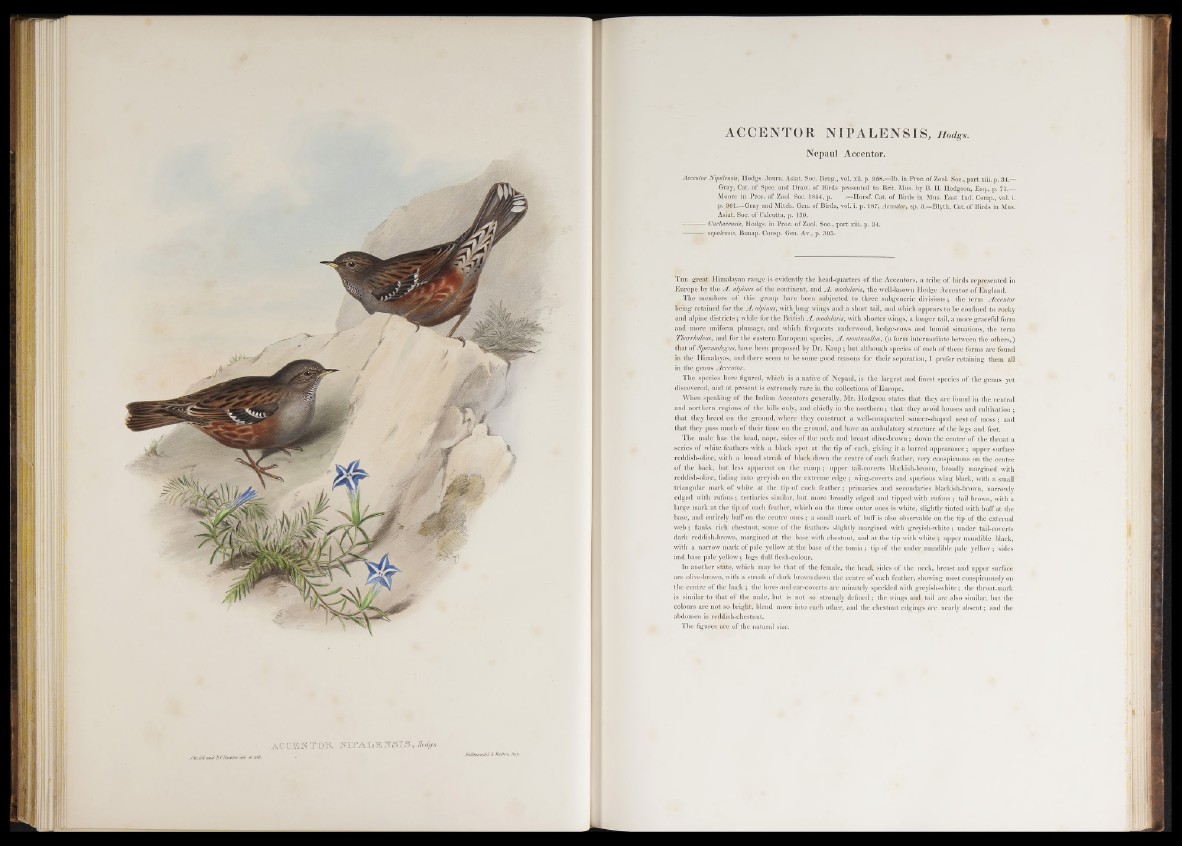
ACCE5TT0R. NIPALElTSlS,Mt y
JGoxM and HCIUttátr M tt titfv
ACCENTOR NIPALENSIS, Hodgs.
Nepaul Accentor.
Accentor Nipalensis, Hodgs. Journ. Asiat. S o g . Beng., v o l . xii. p. 958.— lb. in Proc. of Zool. Soc., part xiii. p. 34.—
Gray, Cat. of Spec, and Draw, of Birds presented to Brit. Mus. by B. H. Hodgson, Esq., p. 71.—:
Moore in Proc. of Zool Soc. 1854, p. .—Horsf. Cat. of Birds in Mus. East Ind. Comp., vol. i.
p. 361.—Gray and Mitcb. Gen. of Birds, vol. i. p. 187, Accentor, sp. 3.—Blyth, Cat. of Birds in Mus.
Asiat. Soc. of Calcutta, p. 130.
— Cacharensis, Hodgs. in Proc. of Zool. Soc., part xiii. p. 34.
— nepalensis, Bonap. Consp. Gen. Av., p. 305.
T h e great Himalayan range is evidently the head-quarters of the Accentors, a tribe o f birds represented in
Europe by the A . alpinus of the continent, and A . modularis, the well-known Hedge Accentor of England.
The members o f this group have been subjected to three subgeneric divisions; the term Accentor
being retained for the A . alpinus, with long wifigs and a short tail, and which appears to be confined to rocky
and alpine d istricts; while for the British A . modularis, w ith shorter wings, a longer tail, a more graceful form
and more uniform plumage, and which frequents underwood, hedge-rows and humid situations, the term
Tharrhaleus, and for the eastern European species, A . montanellus, (a form intermediate between the others,)
that of Spermolegus, have been proposed by Dr. Kau p ; but although species of each of these forms are found
in the Himalayas, and there seem to be some good reasons for their separation, I prefer retaining them all
in the genus Accentor.
The species here figured, which is a native of Nepaul, is the largest and finest species o f the genus yet
discovered, and a t present is extremely rare in the collections of Europe.
When speaking of the Indian Accentors generally, Mr. Hodgson states th at they are found in the central
and northern regions of the hills only, and chiefly in the n o rth ern ; that they avoid houses and cultivation ;
that they breed on the ground, where they construct a well-compacted saucer-shaped nest o f m o ss; and
that they pass much o f their time on the ground, and have an ambulatory structure of the legs and feet.
The male has the head, nape, sides of the neck and breast olive-brown; down the centre of the throat a
«cries o f white feathers with a black spot a t the tip o f each, giving it a barred appearance; upper surface
reddish-olive, with a broad streak of black down the centre of each feather, very conspicuous on the centre
of the back, but less apparent on the rum p ; upper tail-coverts blackish-brown, broadly margined with
reddish-olive, fading into greyish on the extreme edge ; wing-coverts and spurious wing black, with a small
triangular mark of white a t the tip o f each feath er; primaries and secondaries blackish-brown, narrowly
edged with rufous; tertiaries similar, but more broadly edged and tipped with rufous ; tail brown, with a
large mark at the tip o f each feather, which on the three outer ones is white, slightly tinted with buff at the
base, and entirely buff on the centre ones; a small mark o f buff is also observable on the tip of the external
web ; flanks rich chestnut, some o f the feathers slightly margined with greyish-white; under tail-coverts
dark reddish-brown, margined at the base with chestnut, and a t the tip with white*; upper mandible black,
with a narrow mark of pale yellow at the base of the tomia; tip o f the under mandible pale yellow; sides
and base pale yellow; legs dull flesh-colour.
In another stfte, which may be that of the female, the head, sides of the neck, breast and upper surface
are olive-brown, with a streak of dark brown down the centre o f each feather, showing most conspicuously on
the centre of the hack ; the lores and ear-coverts are minutely speckled with greyish-white; the throat-mark
is similar to that of the male, but is not so strongly defined; the wings and tail are also similar, but the
colours are not so bright, blend more into each other, and the chestnut edgings are nearly absent; and the
abdomen is reddish-chestnut.
The figures are of the natural size.